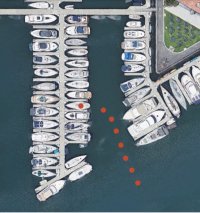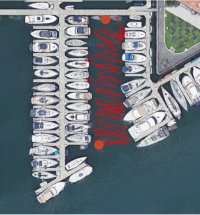I wound up helpless a few days ago, and in need of a tow. I knew it would happen sooner or later, and was well aware of why it might. The reason: prop walk.
I back 38' Thelonious II into a slipway just 50 feet wide. Prop walk helps make the initial backwards turn to port, which is always dicey. The expected path looks like this, and usually comes out fine. The departure angle at dots 2 and 3 is critical.

But on Friday, to compensate for a freshening breeze of maybe 10 knots, I overcorrected the initial turn. By dot 3 I was doomed. Despite having used only a minor burst of throttle, enough to get some sternway (then into neutral), the prop walk to port had begun. At 1 knot the rudder was ineffective. Without remedy we would collide with the outer dock.

This has happened to me before, and with patience I've been able to zig zag in place until luck pointed either end of the boat toward escape to the wide fairway. I have done that for 20 minutes, confident in my skills of pirouetting a 16,000-pound sailboat within inches of other vessels using sensitive throttle and shift controls at speeds of 1/4 knot. Ah, but this time there was a breeze. As I maneuvered--for what seemed like half an hour--I could never get either bow or stern to point toward freedom. This was the resulting path.

The boat could not be turned into the wind. Eventually (vertical squiggles above) I positioned the boat pointed the right direction, helped by sailors on the sharp bows of two moored boats. But it was not possible to engage forward gear there, because the stern would swing into the push-off boats. With help, I finally maneuvered Thelonious II broadside to the end-dock and got the dockmaster to tow me out with a club utility boat.
I mention this because it reveals the Helpless Position auxiliary sailboats can encounter in the absence of bow thrusters.
I was alone, as I often am--a crew aboard could have probably got us pointed correctly with a boathook. When helpers arrived, I tried a warp to haul the bow around, but the line had to be 200 feet long, and carrying it to the proper point meant clambering bow-to-bow over half a dozen vessels, an awkward and time-consuming exercise. My efforts to float a warp across the slipway failed because the warp sank. A dinghy was needed.
I was surprised to find no solution for a singlehander in this particular set of circumstances. I'll continue to back out the same way, as there's no good alternative. I'll continue to do it solo, because in a calm I am still confident I can do it. But any breeze will make for pause.
Things go wrong, and when they do, sometimes there's no escape from the Helpless Position. Good to think twice before we get into it.
I back 38' Thelonious II into a slipway just 50 feet wide. Prop walk helps make the initial backwards turn to port, which is always dicey. The expected path looks like this, and usually comes out fine. The departure angle at dots 2 and 3 is critical.

But on Friday, to compensate for a freshening breeze of maybe 10 knots, I overcorrected the initial turn. By dot 3 I was doomed. Despite having used only a minor burst of throttle, enough to get some sternway (then into neutral), the prop walk to port had begun. At 1 knot the rudder was ineffective. Without remedy we would collide with the outer dock.

This has happened to me before, and with patience I've been able to zig zag in place until luck pointed either end of the boat toward escape to the wide fairway. I have done that for 20 minutes, confident in my skills of pirouetting a 16,000-pound sailboat within inches of other vessels using sensitive throttle and shift controls at speeds of 1/4 knot. Ah, but this time there was a breeze. As I maneuvered--for what seemed like half an hour--I could never get either bow or stern to point toward freedom. This was the resulting path.

The boat could not be turned into the wind. Eventually (vertical squiggles above) I positioned the boat pointed the right direction, helped by sailors on the sharp bows of two moored boats. But it was not possible to engage forward gear there, because the stern would swing into the push-off boats. With help, I finally maneuvered Thelonious II broadside to the end-dock and got the dockmaster to tow me out with a club utility boat.
I mention this because it reveals the Helpless Position auxiliary sailboats can encounter in the absence of bow thrusters.
I was alone, as I often am--a crew aboard could have probably got us pointed correctly with a boathook. When helpers arrived, I tried a warp to haul the bow around, but the line had to be 200 feet long, and carrying it to the proper point meant clambering bow-to-bow over half a dozen vessels, an awkward and time-consuming exercise. My efforts to float a warp across the slipway failed because the warp sank. A dinghy was needed.
I was surprised to find no solution for a singlehander in this particular set of circumstances. I'll continue to back out the same way, as there's no good alternative. I'll continue to do it solo, because in a calm I am still confident I can do it. But any breeze will make for pause.
Things go wrong, and when they do, sometimes there's no escape from the Helpless Position. Good to think twice before we get into it.
Last edited:


